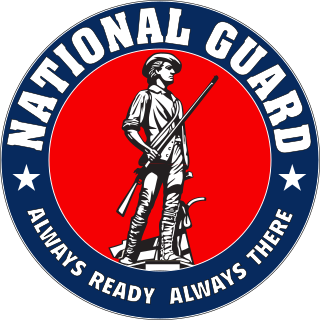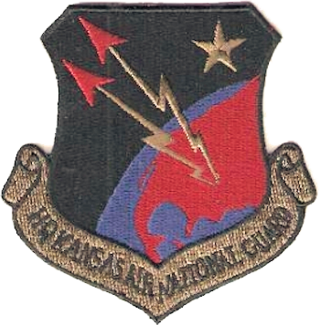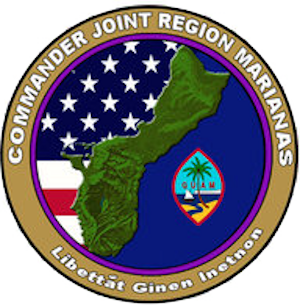This article needs additional citations for verification .(October 2008) |



The Guam National Guard is the National Guard in the United States territory of Guam, made up of the Guam Army National Guard and the Guam Air National Guard.
This article needs additional citations for verification .(October 2008) |



The Guam National Guard is the National Guard in the United States territory of Guam, made up of the Guam Army National Guard and the Guam Air National Guard.
The National Guard of the Island of Guam can be traced back to the first military organization on the island known as the Guam Militia. The Guam Militia was first organized by Governor Mariano Tobias during the Spanish colonial period on Guam in 1771 but was disbanded in 1885. It was later reestablished on March 25, 1917, under U.S. Naval Governor Roy C. Smith because island residents requested more physical and military training be required of their younger male population. Thus, it became mandatory for males, 18 years or older, to attend drills on Sundays from 8 a.m. to 11:30 pm. at the Plaza de Espana in Hagatna. As a quasi-military force, the unit members were neither compensated nor provided with uniforms and equipment. However after World War I salvage operations on the scuttled SMS Cormoran led to recovered Mauser rifles being issued to the militia before they were replaced with newer weapons in 1921. [1]
The Guam Militia grew to as many as 1,750 members, consisting of 77 officers and 1,674 enlisted men, by March 1, 1935 and was later reorganized into a voluntary military force.[ citation needed ]
On December 10, 1941, U.S. Naval Governor Captain C.J. McMillin conceded to the Imperial Japanese Army who forced the Militia to become inactive; however, it was never disbanded. During the Japanese occupation of Guam, the Imperial Japanese Forces subjected the island natives, Chamorros, to death, torture and enslavement over the next two and a half years.[ citation needed ]
The U.S. Marines’ recapture of Guam on July 21, 1944 liberated the Chamorro people and returned full ownership of the island to the United States. Guam is the only U.S. possession, with a sizable population, to ever be controlled by a foreign government for a significant period of time.[ citation needed ]
By December 11, 1950, Governor Carlton Skinner had the Guam Militia reconstituted as a voluntary force commanded by Colonel Juan Muna, whose name is still used to day for the Guard’s main headquarters, Fort Juan Muna. Militiamen Tomas R. Santos and Joaquin Charfauros, members of the original pre-World War II Guam Militia, were appointed as honorary Generals of the Guam National Guard. The Guam Militia was legally deactivated in 1956 after the 4th Guam Legislature passed Public Law 23 to provide the necessary basis toward establishing a National Guard for the island of Guam. Congressman Antonio A.B. Won Pat and Governor Ricardo J. Bordallo made significant contributions to the Guam Guard through their negotiations with the U.S. Congress and the National Guard Bureau to establish a Guard structure for Guam.[ citation needed ]
On December 24, 1980, President Jimmy Carter signed Public Law 96-600 introduced by the 96th United States Congress authorizing the establishment of the Guam National Guard. Governor Paul M. Calvo served as the first Commander-In- Chief and Brigadier General Robert H. Neitz was appointed as the first Adjutant General. On July 21, 1981, the Guam National Guard’s Command headquarters was officially established with 32 original charter members. The organization’s personnel strength has grown to over 1,700 members between its Army and Air Guard commands.[ citation needed ] In 1982, the Guam Militia was also legally reestablished as Guam's non-federal state defense force, separate from the Guam National Guard, but is currently inactive. [2]
In 2002, members of the Guam Army National Guard were deployed to participate in Operation Enduring Freedom.
Key components of the Guam ARNG include the 1st Battalion, 294th Infantry Regiment, and the 105th Troop Command, consisting of two quartermaster detachments, a military intelligence detachment and an engineer detachment. [3]
Currently, the Guam Air National Guard consists of a single, non-flying unit, the 254th Air Base Group. The main goal of the Guam Air Guard is to provide ready forces to the Governor of Guam during emergencies, civil crises, and for civil support, as well as to augment and assist the active duty military located at Guam. If activated to federal service, the 254th Air Base Group is gained by the Pacific Air Forces.

The National Guard is a state-based military force that becomes part of the US military's reserve components of the US Army and the US Air Force when activated for federal missions. It is a military reserve force composed of National Guard military members or units of each state and the territories of Guam, the Virgin Islands, Puerto Rico, and the District of Columbia, for a total of 54 separate organizations. It is officially created under Congress's Article 1 Section 8 ability to "raise and support armies". All members of the National Guard are also members of the organized militia of the United States as defined by 10 U.S.C. § 246. National Guard units are under the dual control of state governments and the federal government.

Apra Harbor, also called Port Apra, is a deep-water port on the western side of the United States territory of Guam. It is considered one of the best natural ports in the Pacific Ocean. The harbor is bounded by Cabras Island and the Glass Breakwater to the north and the Orote Peninsula in the south. Naval Base Guam and the Port of Guam are the two major users of the harbor. It is also a popular recreation area for boaters, surfers, scuba divers, and other recreationalists.

The Texas Air National Guard (TX ANG) is the aerial militia of the State of Texas, United States of America. It is, along with the Texas Army National Guard, an element of the Texas National Guard. No element of the Texas Air National Guard is under United States Air Force command. They are under the jurisdiction of the Governor of Texas through the office of the Texas Adjutant General unless they are federalized by order of the President of the United States. The Texas Air National Guard is headquartered at Camp Mabry, Austin, and its chief of staff is Brigadier General Matthew Barker.

The Guam National Guard is a federally funded military force, part of the National Guard of the United States. Guam Army National Guard is the Army National Guard of Guam which, together with the Guam Air National Guard, comprises the Guam National Guard. GU ARNG is the ground component of the Guam National Guard under control of the governor of Guam that performs missions equivalent to those of the Army National Guards of the different states of the United States, including ground defense, disaster relief, and control of civil unrest.

The New Jersey Army National Guard consists of more than 6,000 Citizen-Soldiers. The New Jersey Army National Guard is currently engaged in multiple worldwide and homeland missions. Units have deployed to Iraq, Guantanamo Bay, Afghanistan, Germany, Kosovo, Kuwait, Qatar, Bahrain, and Egypt. The Guard has also deployed to help with the recovery from Hurricane Irma in Texas and the U.S. Virgin Islands, Hurricane Maria in Florida and Puerto Rico, and Hurricane Katrina in New Orleans.

The Florida National Guard is the National Guard force of the state of Florida. It comprises the Florida Army National Guard and the Florida Air National Guard.

The Louisiana National Guard is the armed force through which the Louisiana Military Department executes the U.S. state of Louisiana's security policy. Consisting of the Louisiana Army National Guard, a reserve component of the United States Army; the Louisiana Air National Guard, a reserve component of the United States Air Force; and the Louisiana State Guard, an all-volunteer state defense force, it is directed by an adjutant general appointed by the Governor of Louisiana unless federalized by order of the President of the United States, which places members on active U.S. military duty status.

The Florida Army National Guard is Florida's component of the United States Army and the United States National Guard. In the United States, the Army National Guard comprises approximately one half of the federal army's available combat forces and approximately one third of its support organization. Federal coordination of various state National Guard units are maintained through the National Guard Bureau. The Florida Army National Guard was composed of approximately 10,000 soldiers. The main state training grounds is Camp Blanding.

The Colorado Army National Guard is a component of the United States Army, United States National Guard, and Colorado National Guard. Nationwide, the Army National Guard comprises approximately one half of the US Army's available combat forces and approximately one third of its support organization. National coordination of various state National Guard units is maintained through the National Guard Bureau.

SMS Cormoran or SMS Cormoran II was a German armed merchant raider that was originally a German-built Russian merchant vessel named Ryazan. The ship was active in the Pacific Ocean during World War I. Built in 1909, she was captured by the German light cruiser SMS Emden on 4 August 1914 and converted into a raider at the German colony Kiautschou. She was forced to seek port at Apra Harbor on the U.S. territory of Guam on 10 December 1914. The United States, then declared neutral in the war, refused to supply provisions sufficient for Cormoran to make a German port. After the U.S. declaration of war on April 6, 1917, the Naval Governor of Guam informed Cormoran that she would be seized as a hostile combatant, prompting her crew to scuttle her.

The Sandinista Popular Army (SPA) was the military forces established in 1979 by the new Sandinista government of Nicaragua to replace the Nicaraguan National Guard, following the overthrow of Anastasio Somoza Debayle.

The Battle of Guam was an engagement during the Pacific War in World War II, and took place from 8 December to 10 December 1941 on Guam in the Mariana Islands between Japan and the United States. The American garrison was defeated by Japanese forces on 10 December, which resulted in an occupation until the Second Battle of Guam in 1944.

The Florida Air National Guard is the aerial militia of the State of Florida. It is, along with the Florida Army National Guard, an element of the Florida National Guard. It is also an element of the Air National Guard (ANG) at the national level, falling in with the Army National Guard (ARNG) as part of the greater United States National Guard under the National Guard Bureau (NGB).

The Kansas Air National Guard (KS ANG) is the aerial militia of the State of Kansas, United States of America. It is, along with the Kansas Army National Guard, an element of the Kansas National Guard.

The Washington State Guard is the state defense force of the U.S. state of Washington. It is an element of the state's military forces which also include the Washington Army National Guard and the Washington Air National Guard.

The Rhode Island Army National Guard (RIARNG) is the land force militia for the U.S. state of Rhode Island. It operates under Title 10 and Title 32 of the United States Code and operates under the command of the state governor while not in federal service. National Guard units may function under arms in a state status, therefore they may be called up for active duty by the governor to help respond to domestic emergencies and disasters, such as those caused by hurricanes, floods, or civil unrest.

The Guam Air National Guard (GU ANG) is the aerial militia of Guam, an unincorporated territory of the United States of America. It is, along with the Guam Army National Guard, an element of the Guam National Guard.

Joint Region Marianas' mission is to provide installation management support to all Department of Defense components and tenants through assigned regional installations on Guam and the Northern Mariana Islands in support of training in the Marianas; to act as the interface between the Department of Defense and the civilian community; to ensure compliance with all environmental laws and regulations, safety procedures, and equal opportunity policy; and perform other functions and tasks as may be assigned.
The reserve components of the United States Armed Forces are military organizations whose members generally perform a minimum of 39 days of military duty per year and who augment the active duty military when necessary. The reserve components are also referred to collectively as the National Guard and Reserve.

Sumay, also Sumai, was a village on the United States territory of Guam. It was located on the north coast of the Orote Peninsula along Apra Harbor. It was inhabited by Chamorro people before contact with Europeans. Sumay became a prosperous port town serving whalers and other sailors in the 1800s and the second most populous settlement on Guam after Hagåtña, the capital of the Spanish Mariana Islands. Following the Capture of Guam by the United States in 1898, the village was the site of Marine Barracks Guam. In the early 1900s, it was a link for two firsts connecting the United States and Asia: the first submarine communications cable for telegraph and the China Clipper, the first air service. After the Japanese invasion of Guam in 1941, the residents were evicted and the village turned into a Japanese military garrison. Sumay was leveled during the U.S. liberation of the island in 1944. The U.S. military prohibited the residents from returning, relocating them to the hills of nearby Sånta Rita-Sumai. In 1948, the U.S. military exercised eminent domain and took all private and commercial property at Sumay. Its former location is now on Naval Base Guam.